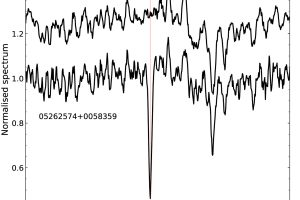A catalog of Lithium abundances from the Gaia-ESO Survey. The study: “The Gaia-ESO Survey: Lithium measurements and new curves of growth” of E.Franciosini (INAF-OA Arcetri) recently appeared on A&A

In astrophysics, there are elements that provide important diagnostics used in various fields, such as Lithium. For instance, measurements of Lithium abundances are important in cosmology where there is a well-known problem of matching the measured abundances in population II stars with those predicted by cosmological models of Big Bang synthesis. Measurements of Lithium abundances are also essential for understanding the evolution of stars and the Galaxy, and for nucleosynthesis in stellar interiors.
These studies require high-resolution spectroscopic observations of large and diverse stellar samples, including stars with different properties such as mass and age, and in different evolutionary phases. Such observations are now available thanks to the Gaia-ESO Survey, which was conducted using the GIRAFFE and UVES spectrographs mounted on the Very Large Telescope at the European Southern Observatory site in Paranal, Chile. This observing campaign included 115,000 stars in different evolutionary phases, including stars in clusters of varying ages and field giant stars.
The team led by astronomer E. Franciosini (INAF – Astrophysical Observatory of Arcetri) analyzed observations from the Gaia-ESO Survey to produce a large and homogeneous catalog of Lithium abundances for stars in the Milky Way. Lithium abundances were measured directly from stellar spectra by comparing the equivalent width of the absorption Lithium line with growth curves obtained from synthetic spectra. Since spectra show the distribution of radiation intensity of the source as a function of wavelength, the equivalent width is the amount of radiation subtracted from the stellar continuum emission at a given line. This emission is “subtracted” because it is absorbed by atoms of the given element (Lithium, in this case) populating the stellar atmosphere. The growth curve shows how the equivalent width of a given line grows as a function of the abundance of that element in the stellar atmosphere. Using this technique, the team measured Lithium abundance in 38,000 stars and compiled the first homogeneous catalog of Lithium abundances in such a rich sample of stars in our galaxy. Both the study and the catalog, the latter being fully available, are described in the paper “The Gaia-ESO Survey: Lithium measurements and new curves of growth” recently published in Astronomy and Astrophysics. Among the coauthors are also L. Prisinzano and G. Micela of INAF – Astronomical Observatory of Palermo.
The figure (click here to visualize the entire image) shows two examples of GIRAFFE spectra of two M stars (with Teff of about 3500 K), which are characterized by different Lithium abundances. The two spectra are almost identical, with the main difference being the absorption line marked with the red line, which corresponds to the Lithium line. The star in the upper spectrum is almost depleted of Lithium, while the star in the bottom spectrum has a high abundance of Lithium.
Mario Giuseppe Guarcello ( follow mariospiegacose) ( mariospiegacose) ( follow mariospiegacose)
Follow the Astronomical Observatory of Palermo on Facebok
Subscribe the Youtube channel of the Astronomical Observatory of Palermo
